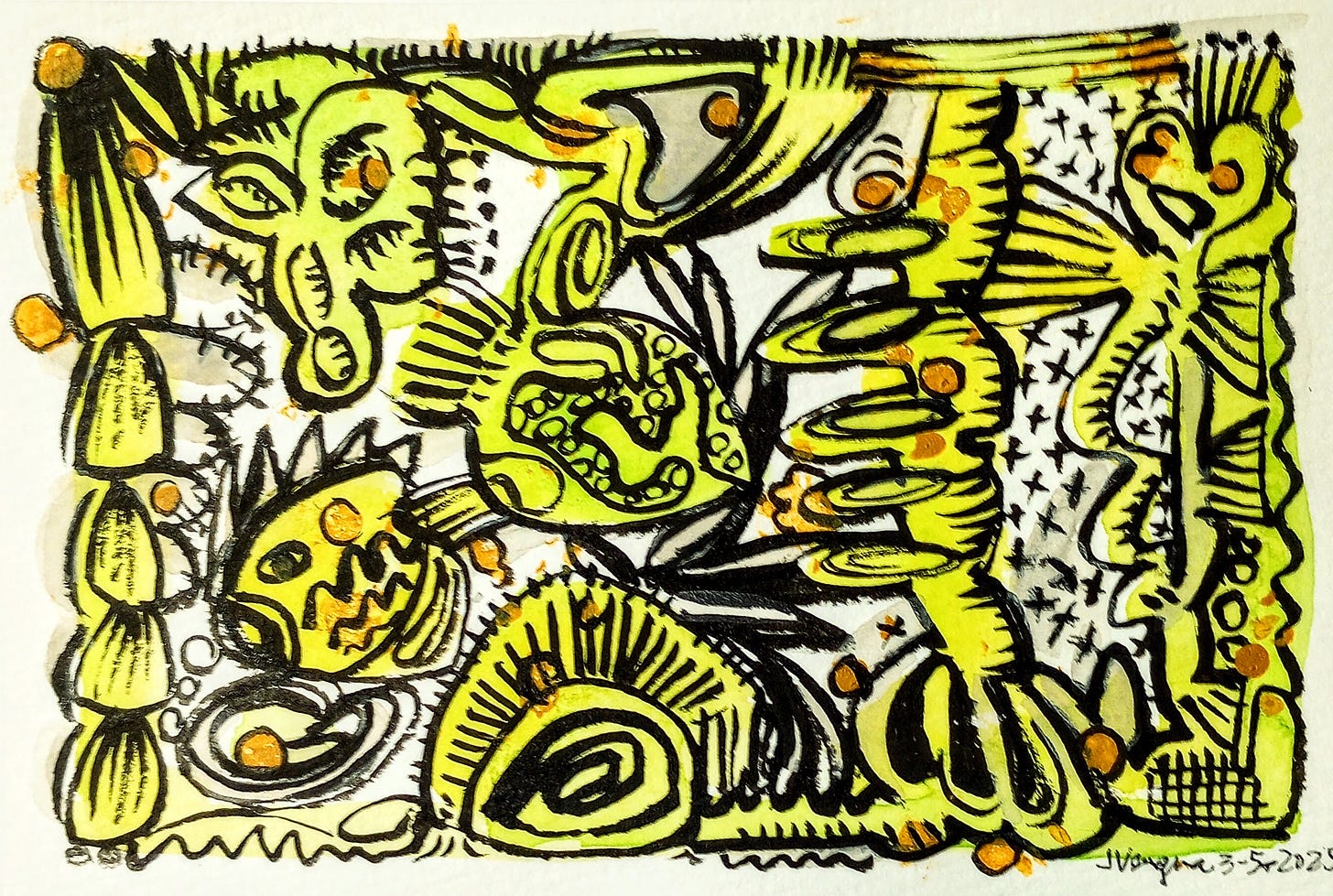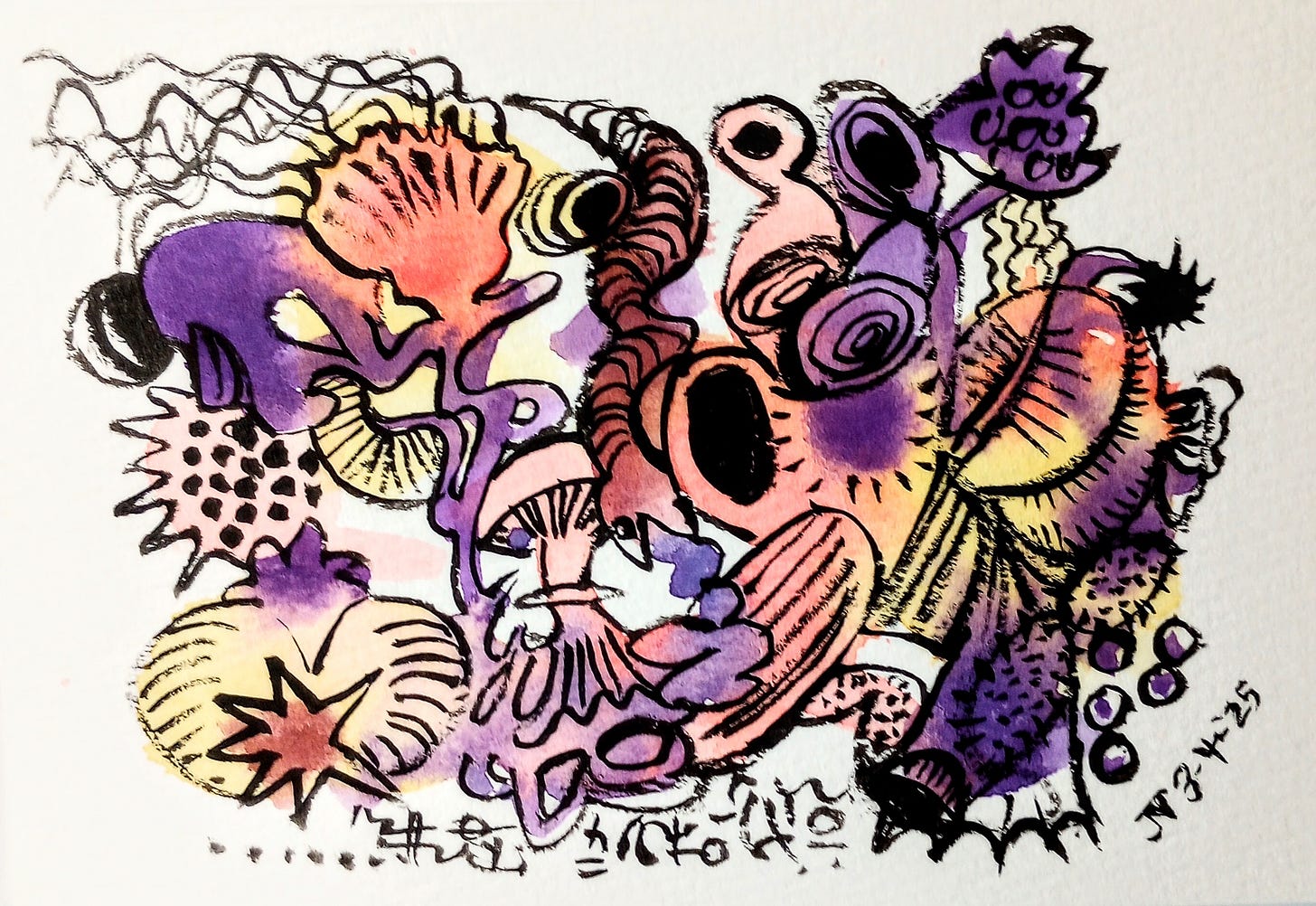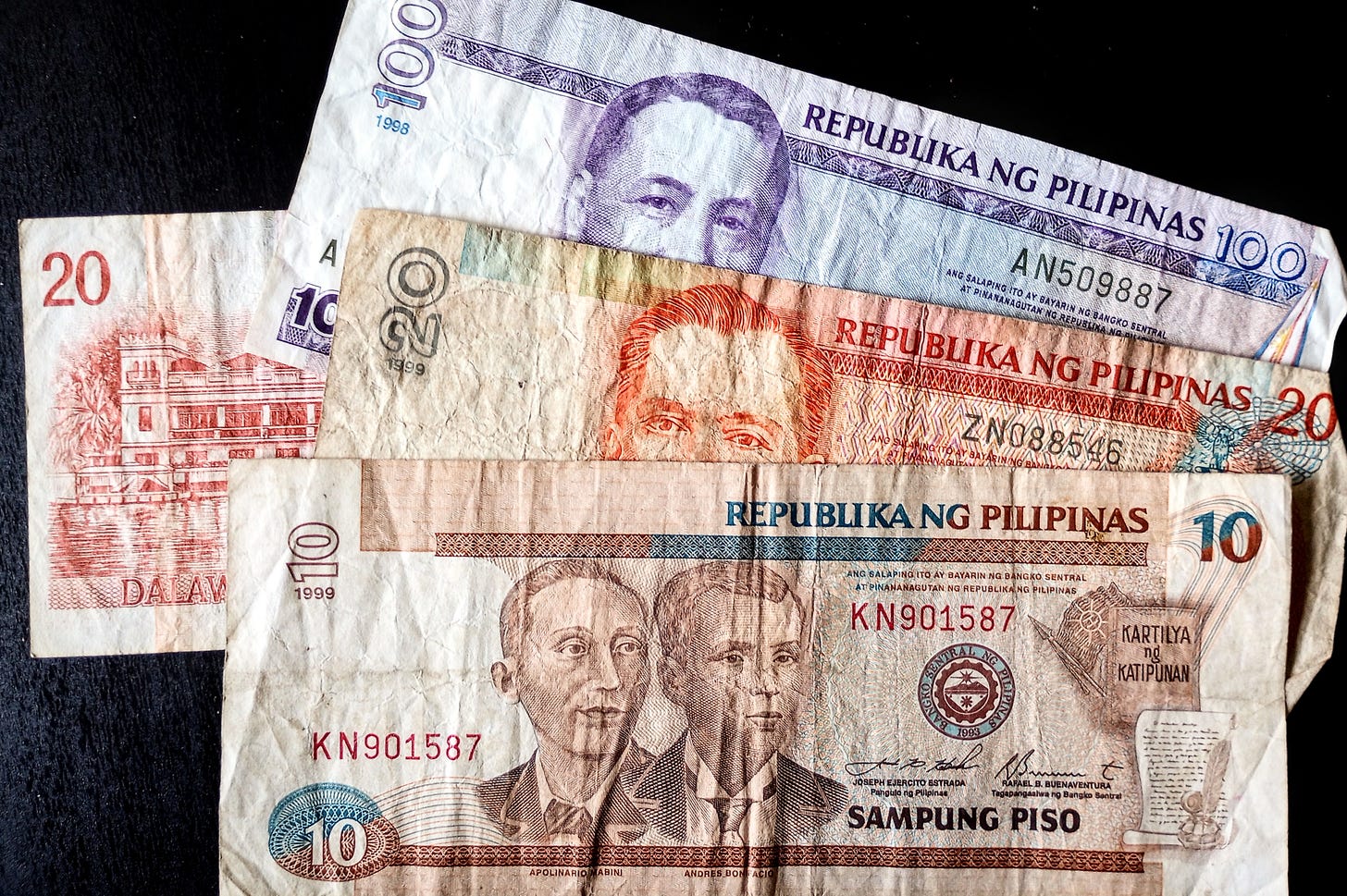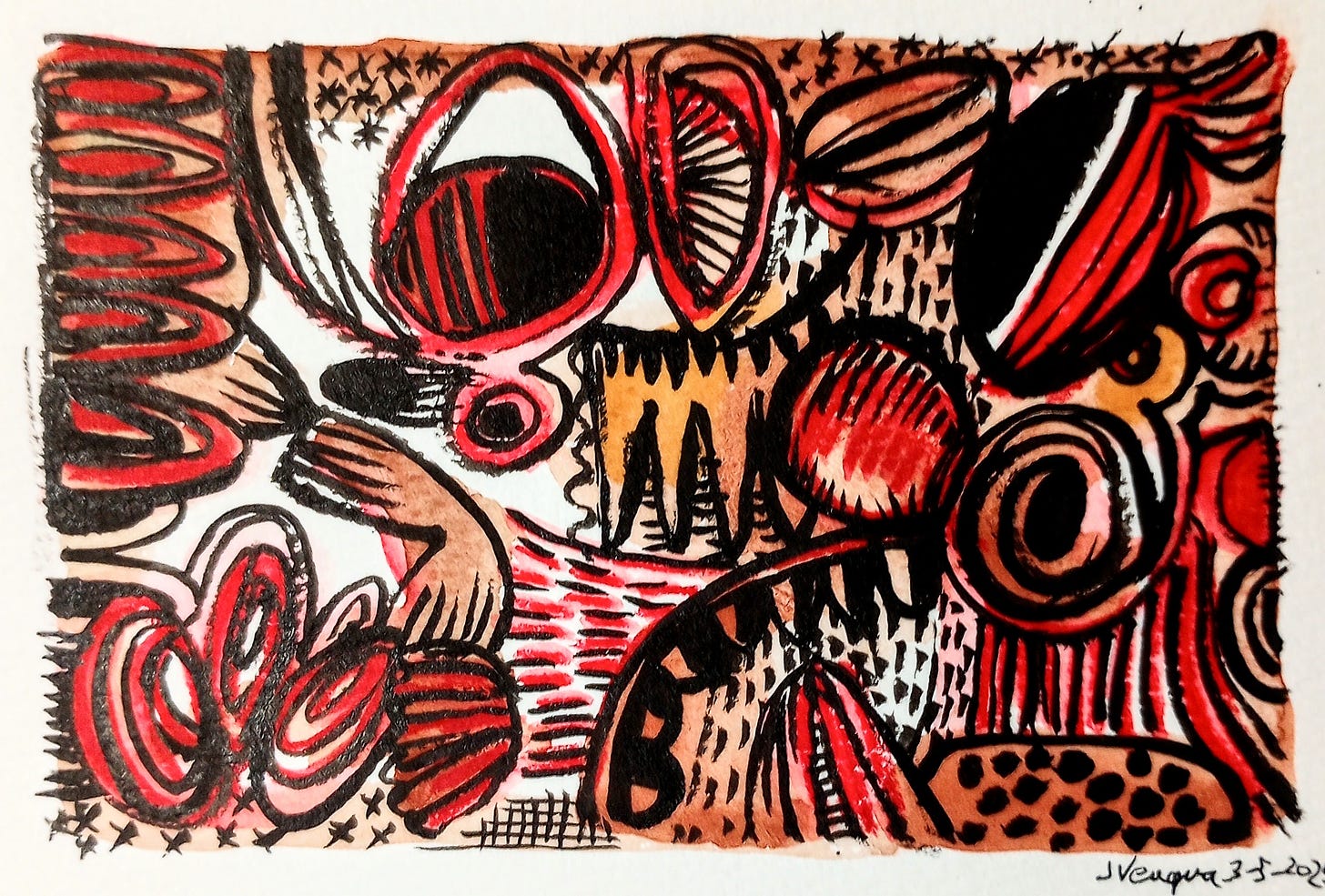Pasalubong, Pesos, and Pining for Home
#188: Then & Now, Art, Kelsey Rodriguez, Viet Thanh Nguyen, Eileen Tabios and Rachielle Sheffler, Kathy Jetñil-Kijiner, David Lynch, Avie Sheck & Mom, and ARIatHOME.
THEN & NOW
In a typewritten letter of April 16, 1956 my dad wrote that his ship, the USNS General Daniel I. Sultan, was “chogging” [sic] its way back to Guam after leaving the Philippines. They would soon head for Kwajalein, a reminder that he was part of the fleet heading to the Marshall Islands, carrying military personnel working on hydrogen bomb testing.
After reading that he had been able to visit her family in Manila, I imagine Mom must’ve felt jealous—and homesick. He included a report on each family member, including my Aunt Dading, who was pregnant again. With some concern, he mentioned how tired my grandmother seemed:
They were surprized [sic] to see me for I got to the house before noon. Fred, Dading and Remy was going to meet me at the gate. Of course your beloved mother was there very happy to see me too. But you know I was happy to have left that evening too for I made the old lady get too tired. She was very busy all day and that evening cooking our supper. I really pity her though she looks very healthy and active as usual. You see honey, their two helps1 left them just before I came. I don’t know for what reasons, they didn’t tell me. Anyway, before I left I gave mother fifty pesos. You should have seen how delighted she was. And she said to me, “maraming salamt sa iyo Nick,”2 her eyes dazzling with joy. It was such a short visit but one very worthwhile.
He also brought a camera for my aunt’s husband, and cookies and candies for the children. Despite his scrimping and saving for our mortgage payments, plus all the extra work he took on cooking and stewarding in military galleys, Dad seemed to enjoy distributing these pasalubong (gifts) to family.
Funny how things [are] as you see, we ourselves haven’t got any [money]. But I just felt proud and get a kick of giving rather than receiving. Darling, I hope you won’t get angry with me for all this habit of mine. I know you could use some of it yourself. anyway, I also happen to know you are just like me too. Nevertheless, our being kind and generous to others isn’t a fault at all, but a God [given] natural feeling with the urge to give . . .
Mom would eventually bring her own pasalubong in balikbayan boxes3 to her family in the Philippines, but she would have to wait almost 30 years for that homecoming. And my grandmother would pass away before then.
In another typewritten letter of May 16, 1956, Dad mentioned his own persistent homesickness, first imagining Mom working on her gardening projects around their new house:
Since it is summer time now I am sure you would like to spend much of your time outside tinkering with the lawn and the flowers and the [garden] in the backyard. I guess that is just quite alright for it gives you an exercise and something to preoccupy your mind and to enjoy in the sunshine.
. . . anyway, I hope you and Jean are well and doing fine just as I always wish you to be. As for myself, I’m alright darling although right this minute I wish I am home with you and Jeanie. Sometime I would really feel very lonesome thinking how far I am from the family. I would imagine a lots of things especially when I lay on my bed not being able to go to sleep. I hate to feel this way sometime because I would begin to worry helplessly about you two down there being all alone. It happened to me this way many times, and imagine I would spend the night sleepless.
As someone with strong local ties to central coast California, I always struggle to comprehend the global dimensions of my parents’ relationship with each other and with their families—always at a vast distance from one another, always pining for contact, always writing and sending letters. That longing seemed best embodied by gifts either sent through the post, or delivered (usually from the US to the Philippines) by friends or relatives who could afford to make the trip. In every case, those who were willing to drop off pasalubong could expect a meal and a friendly visit, and in turn were expected to bring back some good gossip when they returned to the US.
I suppose the story is similar for most immigrant families, but perhaps more so for Filipinos whose culture has, for centuries, centered around seafaring and oceanic trade.
ART
Most of my creative activities this year have focused on non-fiction newsletter writing4 and mail art (often on postcards or on art small enough to fit in an envelope). One of the things that appeals to me about mail art is its reciprocal and collaborative nature. Perhaps it resonates with my sense of kapwa, the Filipino sense of interconnectedness.
My federal taxes have increased over the past several years. To keep it down, I decided not to sell any art last year (which means not joining any open studio projects, nor submitting my art for local art shows5)—which helped to keep expenses AND taxes down.
That seems like the opposite from what one should do; if taxes go up, you’re supposed to raise your prices. But I’ve decided that sharing my art freely within my community is actually more rewarding for me than getting paid for the work. Many artists I know would probably think that’s crazy, or even sad, and that I’m devaluing my art and the work I put into it; “you’re worth more than that!” they would say—turning me into another commodity.
Well, I’m tired of viewing my art in terms of work and profit (which also forces me to constantly compare my art and prices with those of other artists) and calculating the hours I put into each piece, as though I were working a boring office job.
Recent Mail Art:


RABBIT HOLE
Artist Kelsey Rodriguez discusses how the current tariff war is already affecting artists and artisans who are trying to sell their creations:
I’m looking forward to seeing the HBO series based on Pulitzer Prize-winning author Viet Thanh Nguyen’s book The Sympathizer, which is coming out next week. Aside from his being a fantastic author, I’m also rooting for him as a member of my graduate cohort at UC Berkeley:
Author and artist Eileen R. Tabios on “Dictatorship, Didacticism, Kendrick Lamar, and Venancio Igarta” (interview by Martha Cinader). Is it possible to create lyrical and/or abstract art that also contains a political message? How do viewers of art participate in (and perhaps extend) the artist’s project? See also Rachiel Sheffler’s review of the Balikbayan Artist:
“Midnight,” a poem for Tony deBrum by Kathy Jetñil-Kijiner:
I’ve always thought that director David Lynch’s fixation with Transcendental Meditation was a bit corny, especially since he was a chainsmoker and produced very dark and disturbing films. But then I watched an interview with him and Naomi Watts, and I think I get where he was coming from. So much of his interest in meditation was tied to his sense of creativity and the “bliss” of that process. It doesn’t matter that he was a chainsmoker or that he had his faults—that’s just the reality of the human condition.6 Meditation is not necessarily going to get rid of our shortcomings. What matters is that he had a glimpse of truth and that it fed his creative spark. David Lynch on “Meditation, Creativity, Peace,” an hour-long documentary:
SOUNDINGS
Chris Santos, aka DJ Flow on solving “human puzzles” one track at a time. He’s a Filipino American old-school DJ, very much into records:
A lot of the stuff didn’t make it to digital, and so I’m really into discovering new things,” Santos says, describing his solo trips to the record store as a kind of meditation. “The ritual of finding records, reading the backs of them, looking at the covers — it’s almost like you’re exploring history as well.
I was never a big fan of Coldplay’s hit song “Yellow.” But Avie Sheck and his mom Uma do a lovely rendition of it here. Avie’s mom is classically trained as a traditional Indian vocalist, while Avie was raised in L.A. and his musical choices reflect that. Their collaborations bring the two cultures together beautifully:
While you are at it, check out their surprisingly empathetic cover of Radiohead’s “Creep.” A pretty depressing song—but listen to their discussion about its significance for both of them.
This is a fun video if you like off-the-wall street music. Ari takes his rig into NYC neighborhoods and encounters some talented people to jam with:
My gratitude goes to everyone who reads Eulipion Outpost regularly, and especially to those who have subscribed or donated on my Ko-fi page to support my efforts.
My ongoing appreciation goes to the Mysterious M. for his excellent editing skills.
Website and blog: Jeanvengua.com
A Crooked Mile (a blog)
CommonwealthCafe (Filipino American & AAPI history and print culture)
Eulipion Outpost is a reader-supported publication. To receive new posts and support my work, consider becoming a free or paid subscriber.
Hired help; very common in the Philippines, even for middle and some working-class families.
"Thank you very much, Nick.”
Balikbayan boxes held pasalubong goodies brought by immigrants returning home.
Which may go towards a future book project.
Except for the Paraluman Art Show in Salinas Chinatown.
I’ve experienced some moments of heightened awareness during meditation; they didn’t get rid of my bad habits, but those special moments forever changed my perspective of life.








Enjoying your discoveries as you open, read and preserve the letters of your parents. It's like walking into a dream; but it is real his(her)story. The Archivist will not be denied. I've always thought of my parents as immigrants; i am a child of immigrants. "Diasporic" study now becomes more urgent as I am learning from tracing my first cousins, (from my Father's two youngest brothers did not make it to the USA at the onset of the Tydings McDuffe Act 1934). They ventured to Mindinao and my first cousins to Nigeria, New York and Ottawa, Canada. Will be traveling to Ottawa to meet my first cousin for the first time. Fe is 82 years young. She is overjoyed about my archival projects.Gotta bring her some California pasalubong. Salamat at Agyamanac
Letters took a long time to get to us here in the Philippines, too. My childhood best friend moved to San Jose in the early '90s, and I'd go four to six months between letters from her. The dates she wrote and the stamps from my local post office were dead giveaways 🙃
Lovely art as well! And I miss those old peso notes, especially the torn and defaced ones 🤭 Our current ones look more modern and secure, but also less sturdy.